Why our playing-cards look the way they do
Analysis of early playing card designs: origins, suit differences, standardization, technological advancements and key innovations leading to modern designs.
Let’s begin in 1376, when playing-cards started to appear in Southern European countries bordering the Mediterranean Sea. These differ from other cards (Chinese and Indian say) in at least three important ways that we still see today. Firstly, they are arranged in suits, specifically four. Secondly, we have a hierarchy of rankings, with court cards at the top and numbered cards below. Thirdly, the court cards show pictures of people.
From the very earliest days, the suit names and their depictions are different in different areas. In the South, we have Swords, Cups, Coins and Batons, all still visible on Spanish and Italian playing cards today. In the North we have Leaves, Hearts, Bells and Acorns, still seen in Germanic countries.
The suit names and signs adopted by the English and Americans initially came from France. They are much more abstract. After 1400, it is thought that a French maker created these so that they could be stenciled instead of being printed in color. This applies to every ‘pip’ on every card, making the process much quicker and cheaper.
Modern French cards come in only one design, the ‘Paris Pattern’ following a Law of 1701. Before then there were a dozen or so regional variations. This is significant because it helps answer a ‘Frequently asked Question’, namely “what is the significance of the choices/ poses of the court figures?”
The Jacks illustrated above all show what must be the same figure in the same pose, but it has been given different suits in different regions. We also see examples where the same figure is shown sometimes facing right and sometimes left. The use of a common set of figures in differing ways was first noted by English card expert Ken Lodge. Conclusion: the exact details have no significance!
The English began making cards around 1600, and they were copies of a pattern from Rouen, France.
The English cards appear more abstract for a reason noted by the IPCS: the copying was done very frequently and the images deteriorated more and more. This is not abstract design but pure error!
A New Ace of Spades
A significant change came in 1765, when England introduced a special Ace of Spades. These aces were printed by the Tax Office and card makers had to buy them, thereby paying the tax. This was then added to the selling price of the pack.
At the time, card makers were printing with wood blocks and these aces were printed by metal engraving, a more expensive technology capable of fine detail. The idea was to make the design hard to copy. The aces were printed in sheets of twenty, each having a number. In the Yates and Barnes illustrated Ace above, you may be able to see “No 2” across the design under the spade sign. This was in case of small differences in engraving: any ace found in use could then be compared with the exact same reference ace out of the twenty.
The tax on playing cards is no longer with us but we now expect to see a fancy, highly decorative ace of spades normally showing the maker. The system has also left us with the impression that numbering packs makes them more official. Sometimes this is on the box, sometimes on the Ace of Spades – see the examples below.
The First Standard 1765-1832
With the new Ace of Spades in place, we recognize the first standard pattern. To recap briefly, we have the French choice of simplified suits and the full-length court cards from Rouen. A century or more of poor copying has made the designs abstract. We then have the idea of an elaborate and numbered Ace of Spades.
Revolution!
Soon after 1830 changes began to come quickly. The first change was in the printing technology. Trained as a printer, Thomas De La Rue began to use lithography in 1832. This change had an enormous impact: it took playing card making out of the artisans’ shops and onto the factory floor. Mass production followed rapidly. In the US, industrial printing was pioneered by Lewis Cohen.
Around 1840, De La Rue had another lasting idea – colorful printing on the backs of card. Until then, card backs were usually plain, or very simply decorated. De La Rue commissioned a well-known architect and artist, Owen Jones, to produce attractive back designs. These soon became the norm and we now find it hard to imagine cards without printed back designs.
Double Ends: Late adopters

Above: An early English double-ended version made almost literally by cutting the single figure in half and repeating it below.
Modern cards have two ends – the court figures have been cut in two and reflected over the middle line. This very obviously makes it much easier to arrange a hand of cards. The English and the Americans were very late adopters of this idea. European cards started to become double ended before 1800 while the idea is rare in Anglo-American cards before 1850 or so.
The next two innovations came from the New York firms, particularly Samuel Hart. Firstly, Hart introduced ‘corner indices’. These are the small pip signs and numerals shown in the corners of each card. The great advantage is that players can see what they hold by fanning the cards a little, instead of having to go through the cards one at a time.
Unintentionally, this innovation gradually liberated the faces of the cards. The card faces can nowadays show a set of souvenir photographs or abstract art: as long as they show these corner indices, we can still play card games with them.
The other New York innovation was the Joker, brought in for Euchre. This card can now be used in other games as a spare card if one is lost, or as a wild-card for amusing variations on standard rules. Unlike other cards, the Joker did not come with a standard appearance, and card designers have exploited this to maximum effect with imaginative and amusing designs.
The Modern Standard from around 1890
So, after 1830 a lot of changes came in a short space of time: double ends, lithography, printed decorative backs, corner indices and Jokers. Once all these changes had been absorbed – and of course widely copied - things settled and a new standard emerged. Now some 130 years later, the 1880s designs are still familiar.
References
- Bostock, Paul; Clear the Decks, 52 Plus Joker, Vol. 32, No. 1 (June 2018)
By Paul Bostock
United Kingdom • Member since May 07, 2024 • Contact
Paul has been a collector of playing cards since his early teenage years, the mid 1970s. In the last 20 years or so he has specialised in standard English cards and their story. His collection, including many other English Standards, are featured on his website plainbacks.com. Paul is currently editor of Clear the Decks, the Journal of 52 Plus Joker, the American club for playing card collectors, and is a member of the IPCS Council, an EPCS member and a Past Master of the Worshipful Company of Makers of Playing cards, a City of London livery company.

Related Articles
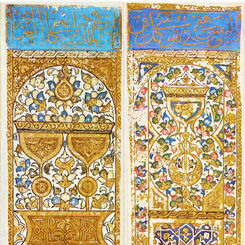
Mamluk Cards and the Making of the European Deck
Mamluk “naib” cards — four suits with named courts — offer a persuasive clue to how playing cards re...
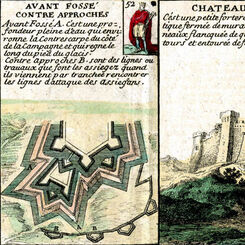
Le Jeu Des Fortifications
An innovation from the time of Louis XIV by Gilles de la Boissière.

76: Transitions: Hunt & Sons
Styles change and technology develops. This means that it's possible to see transition periods in th...

English Pattern by B.P. Grimaud
Standard English pattern published by B.P. Grimaud with engraving by F. Simon, c.1880.
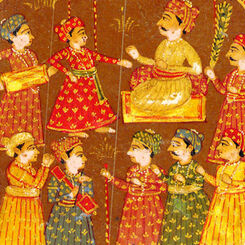
Ganjifa - Playing Cards from India
Indian playing cards, known as Ganjifa, feature intricate designs with twelve suits and are traditio...
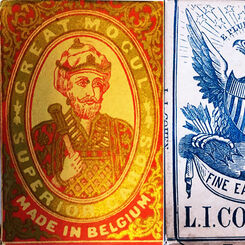
Moguls, Highlanders and Merry Andrews
Discover the historic origins and evolution of card naming and quality designations like ‘Moguls’ an...

Classification of Numeral Card Designs in French-suited packs
The classification of numeral cards in French-suited packs, covering various pip designs in over 400...
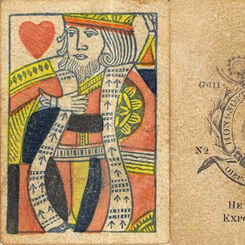
The Henry Hart Puzzle
Explore the intricate history and unique design variations of Henry Hart's playing cards, tracing th...
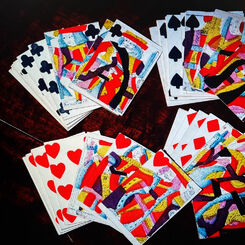
English cards from the reign of Charles II
This article explores a historic pack of English playing cards from circa 1675, likely used by King ...

Introduction to Collecting Themes
Playing cards can be broadly categorised into standard and non-standard designs, with collectors app...
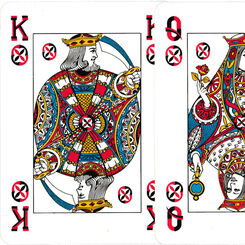
Il Quinto Seme
An Italian pack with a fifth suit of “amici” (“friends”).

Pentacards
A five-suited set of playing cards published by Fleet and Case Games Ltd., Rainham, Kent, UK, c.1980...
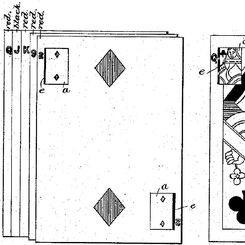
Corner Indices
Corner Indices were a major innovation in playing card production.

Five Suit Bridge
Five Suit Bridge was invented in Vienna in 1937 by Walter W. Marseille and Dr. Paul Stern.
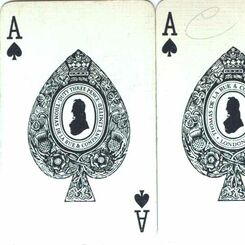
De la Rue’s 125th anniversary
In around 1955 De la Rue introduced a new coloured joker and a series of aces of spades with a silho...

Triplicate No.18
Dougherty first secured a patent for “Triplicates” in 1876, a novel type of indices with a miniature...
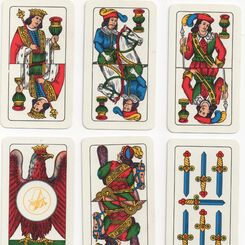
16: European Standard Playing Cards
A brief survey of the different types of standard cards to be found in Continental Europe.
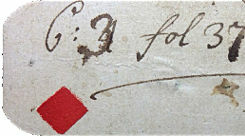
Secondary Uses of Playing Cards
The unprinted backs of playing cards have led people to use them for secondary purposes such as memo...
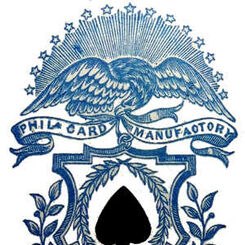
Samuel Hart, 1846-1871
Samuel Hart was a prolific manufacturer of playing cards who commenced business sometime around 1845...

De La Rue
De La Rue introduced letter-press printing into playing card production and his patent was granted i...
Most Popular
Our top articles from the past 60 days



































